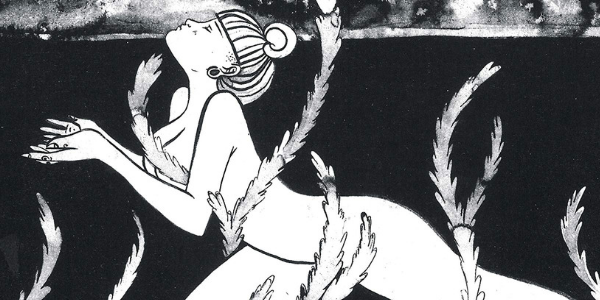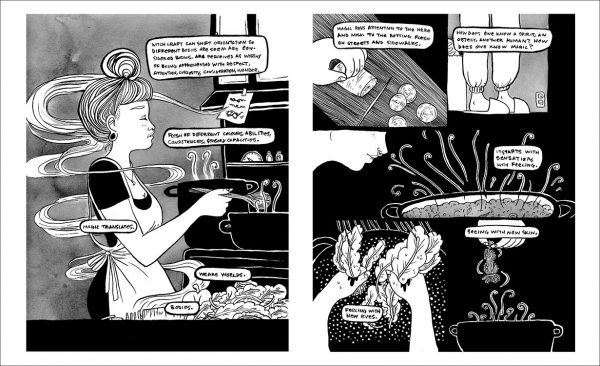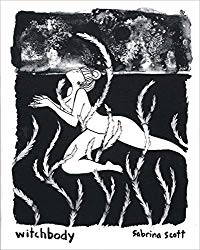
Witchbody: A Graphic Novel, by Sabrina Scott
Weiser Books, 9781578636648, 80 pp., 2019
In 2016 I decided to pursue a degree in ecopsychology, a new branch of psychology that examines how our environment, culture, and psychology are intertwined. My deep passion for environmental activism blossomed hand in hand with my understanding of the sacred duty to protect the earth, cultivate my magick, and blossom as the witch I knew myself to be deep in my bones. As I made my way through graduate school and eventually wrote my thesis, I struggled to find the right words to elucidate the connection of magick and environmental activism that I worked to intertwine in my day-to-day life.
Now, finding Witchbody: A Graphic Novel by Sabrina Scott has immensely excited me, because it resonates so deeply with the work I had been pursuing. In this black and white graphic novel, Scott brings to life an intriguing and deeply profound body of knowledge. It combines philosophy, magick, and environmental activism to help reshape one’s perception of how they relate to the world around them, through her artistic creativity. Witchbody perfectly captures the experience of developing magical relationships, which are inherently rooted in mutual interdependence between ourselves and the world we embody.
Witchbody reinstates physicality into magical practice. Through her illustrations and musings, Scott reminds us that, ultimately, magick is an experiential practice that happens in a space where we can feel, see, and sense the presences of other material bodies surrounding us. She writes, “Witchcraft is a body pedagogy that makes sense of the idea that other bodies may feel us, too.”1
Understanding our locus of existence as situated within a body helps to grasp the concepts that we also exist in the environment of other living things, from plants to insects to animals. For this reason, we learn to treat these environments with care and respect. While we may not be able to verbally communicate with these other living things we co-exist with, we can acknowledge them and feel their presence. When one practices magick, they invoke the will of these fellow entities, whether it be a living or non-living organism, such as an incense stick. According to Scott, all material bodies have a way of being in the world, or an ontological component, which allows them to be connected to by us in our practice, forming a relationship of equality.
Magic is unique because it draws attention to these relationships. In magic, trans-species entanglement is noticed with more frequency and intensity because the agencies of other-than-humans are intentionally enlisted in collaborative efforts to do things, to effect change, to instigate material difference. Within a magical framework, entities don’t exist solely to be exploited by humans.2
It is this change in perception that is crucial to environmental activism at this time, because changing our core behaviours can only stem from a shift in the psychological manner in which humans interact with their environment. Scott frames how these changes can be made in a creative way, using the combination of illustration and short prose, to deliver an impactful and meaningful message about the importance of examining our relationship as a body to the environment.
While reading Witchbody, one grows in their awareness of the connectivity happening between objects on a material plane. Scott highlights how the foundations of magick can be explored in a directly experiential way to shift beliefs and practices to be more conscious of the environment. The spiritual and physical are merged through a re-examination of the sense of beingness of all things co-exisiting within a certain space, or environment, where respect and care is at the core of the mutualistic relationship.

I particularly like how Scott doesn’t focus solely on the beauty of the environment, but challenges the reader to embrace the waste as well. She states, “We must account for the fallen, the dead, the changed, the unnoticed, the ugly — and embrace them in our environment — they aren’t leaving. They are here and they shape us and they are us. We become each other.”3
After reading Witchbody, I started to change my focus as I spent time in nature. Rather than only focus on the beautiful flower, or the mystical tree, I practiced acknowledging the landfill with the same respect and awe I directed towards more pristine environments. Embracing it all, rather than discrediting the smelly, ugly eyesore of trash, seemed to also help me embrace more shadow aspects of myself. I felt changed because I was opening myself to be embraced by all of my environment, or all of my inner self, rather than creating a dichotomy of good and bad.
Scott particularly drew my admiration and respect for re-asserting the importance of the body in philosophy as well. She demonstrates how magick has the ability to shift perceptions of reality away from the frameworks that have constituted environmental exploitation, and back to a body of knowledge based on love and care. She states:
Magic provides an important counterpoint to how knowledge is positioned within colonial frameworks which have in many ways contributed to large-scale estrangement between human bodies to the extent that many humans can only see themselves when the word “body” is referenced or notions of agency and capacity for action considered. Magic — through practice — shifts these understandings, opening up notions of world, body, agency and action. This is philosophy. It is world-making, world-noticing, world-sustaining.4
Scott has created a thoughtful, insightful, immensely creative, and intellectually inspiring graphic novel. I have reread it at least five times, and each time I feel I gain a new awareness. The framework put forth by Scott is a academically paradigm shifting, while also being grounded in experiential magick. I absolutely adore the way she crosses all sorts of boundaries to weave together the marvelous story that is Witchbody, to offer a new way of being in the world that embraces our material existence as deeply connected to the environments we are embodied within to promote ecological activism.
For a review of the self-published version of this book, see also witchbody, reviewed by Psyche.









